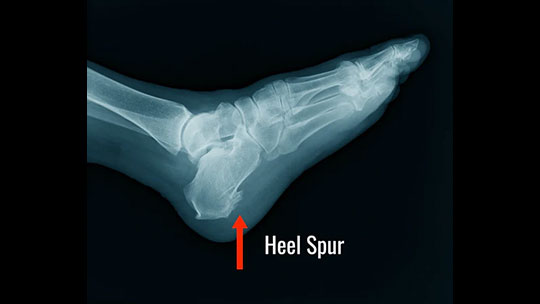Heel Spurs
A heel spur is an abnormal growth of bone that can form on the heel (calcaneus bone). Heels spurs can grow on the back of the heel or underneath the heel behind the sole of the foot. Heel spurs and plantar fasciitis are often thought to be the same, and although they are related, they are different conditions.
WHAT CAUSES HEEL SPURS?
Heel pain and spurs can occur when the plantar fascia ligament that stretches from the heel to the ball of the foot becomes inflamed. The plantar fascia ligament also support the arch of the foot. Calcium deposits can form over time on the heel bone causing mild to serious heel pain when pressure is applied on the foot.
Heel spurs are likely to occur people with flat feet. The band of ligaments and the muscle in the bottom of the foot absorb pressure and the impact of walking or standing. As the arch starts to collapse the ligaments and muscle begin to stretch beyond its limits resulting in torn muscles and bone spurs.
Other possible causes of heel pain and spurs are:
- High arches.
- Tight calf muscles caused by not enough stretching (or proper stretching).
- Muscle tension that pulls away the bone spur.
HOW DO I KNOW IF I HAVE HEEL SPURS?
WHAT ARE THE SYMPTOMS OF HEEL SPURS?
Heel pain is the most common symptom of a heel spur, especially when you first get out of bed in the morning and step down. While you sleep overnight, the foot muscles tighten up, accentuating the pull on the heel bone spur and ligaments. This tightening can make your first steps in the morning very painful.
If you experience the following, you may have a heel spur:
- Heel pain when you begin exercising with, or without, warming up
- Heel pain when you begin moving after a period of inactivity, such as sitting in a car or at work
- Sharp, shooting heel pain when you move
- Sore, painful heel
HOW ARE HEEL SPURS DIAGNOSED?
A physical examination combined with a walking assessment and x-ray will allow for a physician to diagnose a heel spur. A walking assessment is used to detect any gait abnormalities that may be causing the problem. It is important for the physician to discover the underlying cause of the heel spur which may include:
- Plantar Fasciitis
- Gait abnormality
WHAT CAN I DO FROM HOME FOR HEEL SPURS?
WHAT CAN I DO TO PREVENT HEEL SPURS?
The most important thing you can do to prevent heel spurs and pain is to simply take the pressure off the foot. You can also try some of the following:
- Wearing proper footwear
- Give the troubled area an ice massage that will reduce inflammation and relieve tension
- Stretch you calf muscles with proper technique
WHAT TREATMENTS CAN I DO FROM HOME FOR HEEL SPURS?
There are several treatments available for relief of heel spurs and pain, including:
- Insoles that support the arch, reducing tension on the ligament.
- Using a heel pad, cusion, or lift to relieve pressure and reduce inflammation of the ligament where it is attached to the heel.
- Correcting leg length disparities through use of an adjustable heel lift.
- Use a heel cup in your shoes to reduce pressure on the heels by adding extra shock absorption.
- Night splints will maintain the length of the calf muscle so it doesn’t tighten up overnight
- Practice stretching exercises for your calves
WHEN SHOULD I SEE A DOCTOR FOR HEEL SPURS?
You should see a doctor when heel pain becomes repetitive and bothersome.
TREATMENTS YOUR DOCTOR MAY RECOMMEND FOR HEEL SPURS
In addition to the treatments mentioned in the previous section, your doctor may recommend the following:
- Cortisone injection for the heel pain
- Physical Therapy
- In severe cases, heel spurs may require surgical correction.

